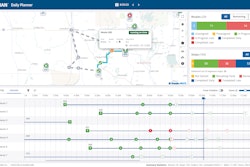
Sustainable business practices have evolved from being a “nice-to-have” to a “must-have” for business leaders aiming to succeed in this evolving supply chain landscape. In turn, this puts pressure on CPG brands to demonstrate greater environmental stewardship and social responsibility across all facets of the business – including the supply chain. According to the International Energy Agency (IEA), the logistics and transportation sector contributes just over a third of all global carbon dioxide emissions.
Here are three ways to integrate sustainability into your fleet management.
Increase Fuel Efficiency
It is not uncommon for truck drivers to keep their engines running during breaks or overnight to power heating, cooling and other electrical systems in their trucks. While this helps ensure driver comfort and safety, it also leads to increased fuel consumption. According to the U.S. Department of Energy, it is estimated that an idling truck can waste nearly one gallon of fuel each hour.
So, how can suppliers increase fuel efficiency without compromising trucker well-being? By partnering with a third-party logistics provider (3PL) that leverages idle reduction technologies such as auxiliary power units (APUs) in its trucks. This technology allows drivers to power necessary onboard systems without idling the main engine. Saving fuel during extended breaks contributes to a greener, more environmentally friendly transportation process.
Optimize Your Route to Retail
In today’s environmentally conscious and cost-driven logistics landscape, retail consolidation presents an attractive solution for suppliers seeking to optimize their supply chain operations. By strategically combining shipments with other brands to streamline the transportation footprint, trucks can operate at full or near-full capacity, minimizing the number of trips required – therefore, reducing the total number of trucks on the road and the occurrence of empty miles driven.
In fact, one consolidated truckload eliminates an average of 13 complex Less-Than-Truckload (LTL) loads. Retail consolidation requires a two-day average transit time, versus LTL’s average five-day transit time, generating 20-30% cost savings. Beyond transportation cost savings, suppliers achieve a greener, more efficient route to retail and increased in-stocks and sales.
Prioritize Proactive Maintenance
In the fast-paced world of logistics and supply chain management, minimizing downtime and ensuring operational efficiency are paramount. By partnering with a 3PL that prioritizes and invests in the health and age of its fleet, suppliers benefit from a more sustainable logistics operation.
With fuel-efficient technologies and proper tire maintenance, suppliers are empowered to minimize their transportation emissions and reduce fuel consumption. For example, the aerodynamic advantages of skirted trailers enable trucks to travel longer distances on a single tank of fuel, improving fuel efficiency, while providing additional safety by stabilizing airflow around the truck and trailer. At the same time, suppliers who leverage a national tire program ensures that tires are not only kept at the optimal air level but are inspected regularly to extend tire life. Emphasizing proper tire maintenance reduces the demand for new tires, conserving raw materials and reducing the environmental impact of tire production. Combined, these initiatives enable suppliers to minimize their environmental footprint and contribute to a more sustainable supply chain.
An Eye on the Future
As the world shifts towards greener fleet management efforts, there is great promise in the adoption of electric vehicles (EVs) and the implementation of other emissions-limiting transportation technologies. Still, challenges remain regarding EV battery life and the charging infrastructure which has slowed widespread implementation. But as you know, advancements are happening every day.
That’s why it is critical for suppliers to embrace sustainable technologies and invest in green programs and supply chain partners to maintain their competitive edge.













![Pros To Know 2026 [color]](https://img.sdcexec.com/mindful/acbm/workspaces/default/uploads/2025/08/prostoknow-2026-color.mduFvhpgMk.png?ar=16%3A9&auto=format%2Ccompress&bg=fff&fill-color=fff&fit=fill&h=135&q=70&w=240)


